There was a time, back in the 1980s, when a Honda Accord seemed special. So cleverly designed, so innovatively engineered, so precisely assembled, the Accord was initially purchased by nonconformists with the courage and smarts to diverge from the mainstream (then still loyal to Detroit). But word spread and sales increased. The Accord became the top-selling model in the U.S. by the end of the decade. Not long after, increasingly locked in a competition with the Toyota Camry for the average American car buyer, the Accord ceased to be perceived as anything special.
The Accord's image bottomed out with the bloated eighth-generation car offered from 2008 through 2012. Though the sedan remained a thoroughly competent, safe choice--now roomier than ever--many people wondered what had happened to the once-innovative company. Honda, admitting that it had lost its way, promised a return to form.
Promises are cheap, though. Could the company actually do it? With the ninth-generation Accord, Honda again fielded a comparison test winner. But people didn't stop thinking of the midsize sedan as a boring choice.
For 2018, Honda has introduced a tenth-generation Accord. Meanwhile, Toyota has felt compelled to make the competing Camry--the boring choice since its 1983 birth--more exciting. Has Honda managed to rekindle the old magic? Or has Toyota managed to beat Honda at its old game? Or neither, and we just have the same old same old? I drove both to find out.
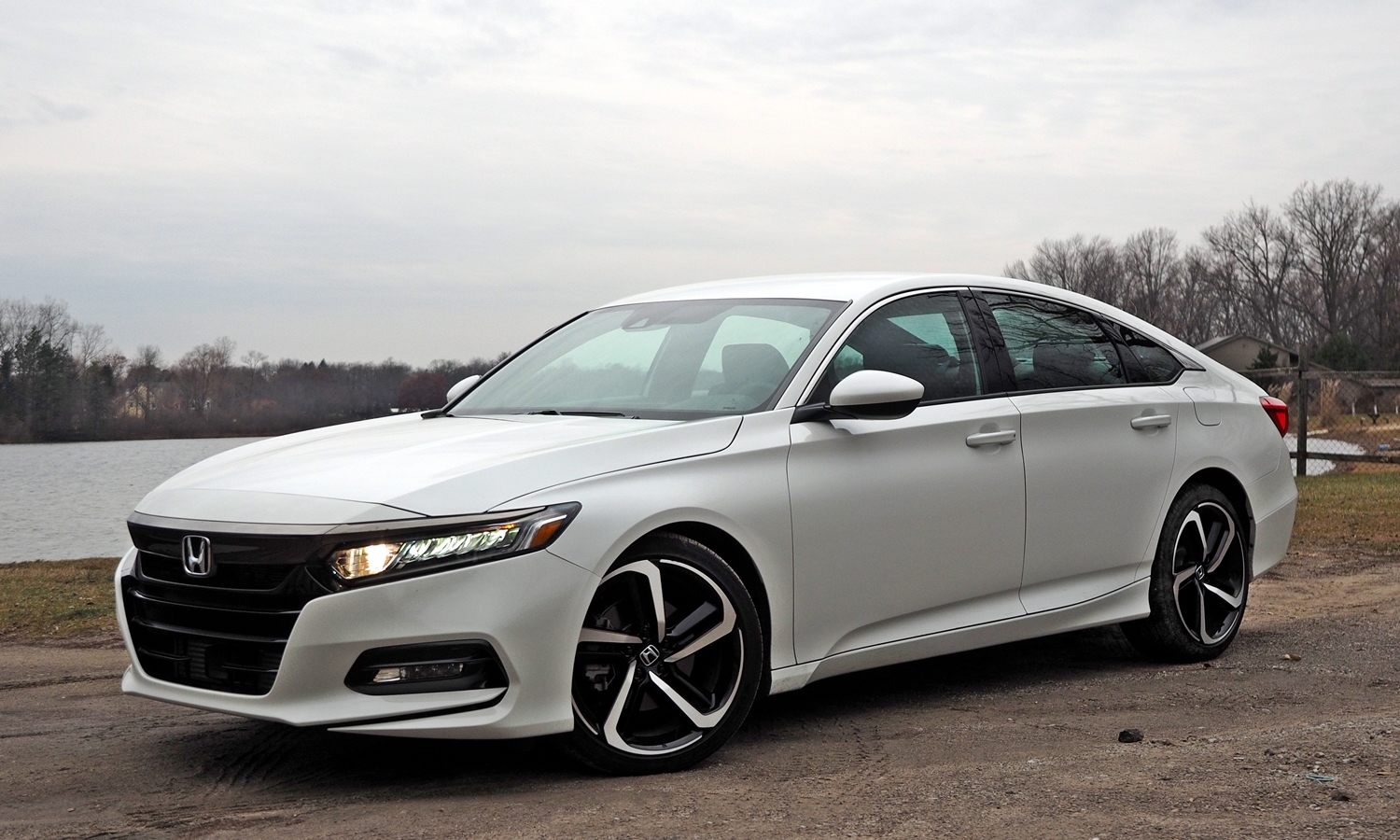
Appears much longer, lower, and wider than the previous Accord and the new Camry--but it's not. more Accord photos

Nothing fancy, yet looks and feels more expensive than it is, even with cloth seats.
| |
Compared to the Camry |
| Handling |
 Better
Worse
Better
Worse
|
The auto industry has made great strides in suspension design and tuning over the past decade. You can no longer buy a clumsy or bone-rattling new midsize sedan. This presented Honda's suspension engineers with a high bar to clear. No matter: they cleared it, and then some.
The new Accord feels lighter and more agile than any competitor with the possible exception of the Mazda6. Partly this is because the new Accord weighs about 150 pounds less than the old one, making it among the lightest midsize sedans. But curb weight isn't everything. The Chevrolet Malibu weighs even less. It just doesn't feel as light. In contrast, Honda effectively designed and tuned the Accord to handle like a smaller, lighter car than it is.
But what really sets the new Accord's handling apart is its almost magical poise. Rush the sedan through some curves, and the contact patches of all four tires feel perfectly situated and coordinated. This car dances. It inspires confidence.
Suspension design and tuning don't deserve all of the credit. Brake-based torque vectoring, new to the Accord for 2018, helps the car feel more agile and balanced than it would feeel without electronic countermeasures. While this technology is increasingly common, it rarely operates as seamlessly as it does in the new Accord. This is what Hondas were known for back in the 1980s: all of the pieces working together so well that pieces were not perceived, only the athletic whole.
Yet room remains for improvement, chiefly with the steering. Honda specified the best sort of electric assist, a motor connected to the rack via its own pinion. When the steering wheel doesn't have to share its mechanical connection to the rack, steering feel tends to benefit. For this reason, Hyundai and Kia employ this type of steering assist only in performance-oriented versions of the Sonata and Optima. To its credit, Honda employs this system in all Accords. But, even in the tested Sport, with firmer tuning, the steering, while quick and precise, could be more communicative and engaging. As it was, for feedback I relied more on the seat of my pants than my fingertips.
Much of the fault could be with the steering wheel itself. Some people, especially those with large hands, like thick steering wheel rims. They'll like the Accord's. But such a thick rim smothers communication from the front tires.
I tested the Accord Sport, which has firmer steering and suspension tuning than other Accords, but which doesn't get the Touring's adaptive dampers. These dampers, which slightly improve ride quality, include a driving mode selector that firms up the steering as well.
The 2018 Toyota Camry handles much better than any previous Camry, but feels less agile, precise, poised, and polished than the Accord. It does have more communicative steering and better outward visibility through larger windows, though. Fun can be had.
| Fuel economy |
 Better
Worse
Better
Worse
|
Back in the 1970s and 1980s, many people initially bought a Honda for fuel efficiency. In my suburban driving with the latest Accord, I often observed trip computer averages in the upper 30s. In two drives the averages topped 40 mpg, a highly impressive figure for a car with the Accord's performance and interior space.
The tested car, a Sport with the manual transmission, actually has the lowest EPA fuel economy ratings of any 2018 Accord with the base, turbocharged 1.5-liter engine: 26 mpg city and 35 mpg highway. The automatic Sport achieves 29 / 35, the non-Sport 30 / 38. Opt for the turbocharged 2.0-liter and the EPA ratings are 22 / 32 for the Sport and Touring, 23 / 34 otherwise. The Sport scores worse in each case due to wider, grippier tires.
The best the previous Accord could manage: 27 / 36.
The base trim Toyota Camry L, while retaining a larger non-turbo engine, outscores the Accord in the EPA's highway test (41 mpg) but can't quite match the Honda in the city test (29 mpg). Other trim levels with the 2.5-liter engine don't fare as well, scoring 28 / 39. With its optional 3.5-liter V6 engine the Camry manages a tie with the Accord 2.0T. That the Camry and Accord score so similarly suggests that turbocharging isn't necessary for top EPA ratings.
The highest EPA mpg ratings earned by the Accord and its competitors:
Honda Accord (1.5T): 30 / 38
Toyota Camry (2.5, L only): 29 / 41
Hyundai Sonata (1.6T): 28 / 37
Nissan Altima (2.5): 27 / 38
Chevrolet Malibu (1.5T): 27 / 36
Mazda5: 27 / 35
VW Passat (2.0T): 25 / 36
Ford Fusion (1.5T): 23 / 34
For even better fuel efficiency, wait for the new Accord hybrid, which will arrive in early 2018. Its EPA ratings should be in the low 50s. The redesigned Toyota Camry hybrid, already available, achieves 51 / 53.

The new Accord appears sleekest and most elegant from the rear quarter.
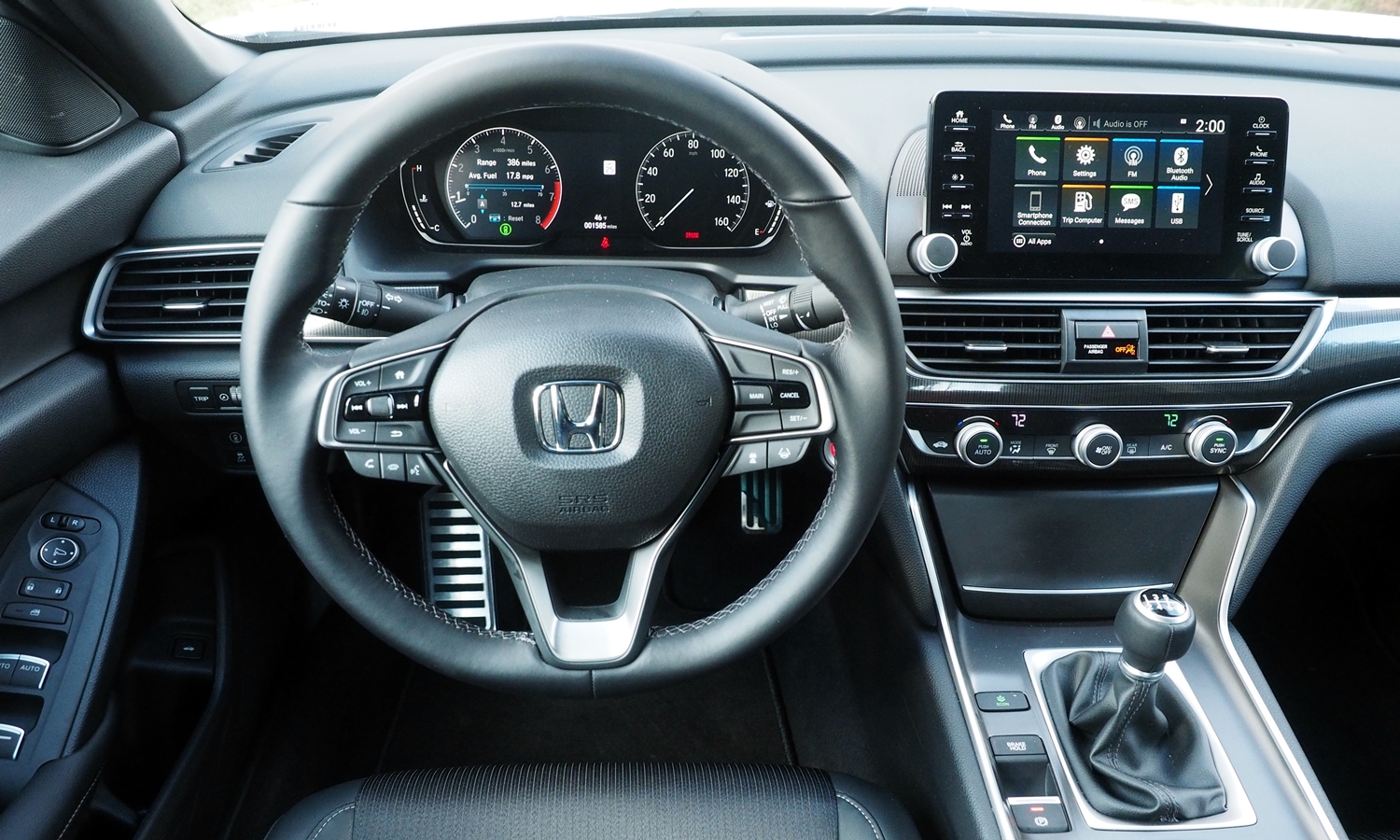
Vastly improved controls from the previous Accord. No starship aspirations.
| Controls and instruments |
 Better
Worse
Better
Worse
|
Back in the 1970s and early 1980s, Honda taglined its ads with "we make it simple." Their instruments and controls were the most driver-friendly in the industry. In no other area did Honda more completely lose its bearings recently. Some Hondas got complicated dual-screen infotainment interfaces. More recently, other Hondas got interfaces with no physical knobs or buttons, only a touchscreen that was too difficult to operate on the fly while driving.
Honda has rectified both errors with the new Accord. The new interface has a single touch-sensitive display, five knobs for key functions, and a reasonable number of physical buttons for others. Very nicely done.
Aside from providing space for the shifter and some controls, the center console ideally holds a fair amount of your stuff, and the Accord's does. I especially enjoyed that my fairly large camera could be stowed securely in an open compartment just behind the shifter.
The Camry's controls and instruments aren't bad, but they aren't as well organized or as easy to use as the Accord's. Noteworthy: the Toyota's touchscreen is positioned lower in its center stack, where it isn't as easy or as safe to view and operate while driving. Not everyone likes the appearance of displays that stick up above the instrument panel, like the new Accord's does. But this enables the combination of a high-mounted display with a relatively low and compact instrument panel, a boon for forward visibility and perceived roominess.
| Rear seat room & comfort |
 Better
Worse
Better
Worse
|
Back in the day, Hondas weren't roomy by any absolute yardstick, but were surprisingly capacious considering their small exterior dimensions. Honda knew how to make the most of a small package.
The Accord grew dramatically over the years. The second-generation 1982 sedan that put the model on the map (literally, they were everywhere) was 173.6 inches long and 65.0 inches wide, on a 96.5-inch wheelbase. The eighth-generation 2008 Accord was over 20 inches longer and 7.7 inches wider, on a 110.2-inch wheelbase.
For the ninth-generation Accord, Honda regained enough of its former space efficiency skills to maintain interior space while slightly shrinking the car's exterior. For the tenth-generation car, they've pulled off a magic trick. Even though the new Accord is 0.3 inches less lengthy, Honda managed to increase total legroom by 1.7 inches. A two-inch wheelbase stretch contributed; to reduce overall length Honda trimmed the car's overhangs. Rear seat passengers now enjoy over 40 inches of rear legroom, a dramatic 2.4 inches more than in the Camry. They will feel like they're in a limo.
What's the catch? Well, those rear seat occupants best not have tall torsos. The lower (by six-tenths of an inch), sleeker roof line cuts into rear headroom. The Camry provides another 0.7 inches for the heads of rear passengers. This might not sound like much until you have a rear seat passenger a bit over six feet in height. Also, Honda only managed as much rear headroom as it did by positioning the rear seat cushion somewhat low to the floor. Some--but not many--competitors have more comfortably positioned rear seat cushions.
I'll note here that the new Accord also has a larger trunk than last year's Accord, the Camry, and every other competitor--but most are within a cubic foot. I'd trade a cubic foot for the interior trunk handle they appear to have considered, then left off the car. Keep the car clean or you'll dirty a hand closing the lid.
| Price or payments |
 Better
Worse
Better
Worse
|
Given how much Honda has improved the Accord for 2018, they've probably raised the price a bunch, right? Well, no. The list price of the base trim LX with CVT (now standard) has increased by only $315, to $24,445. Plus the Honda Sensing suite of collision avoidance tech that was a $1,000 option last year is now standard. Factor it in, and the new and improved car's price has decreased by $685.
But wait, there's more. Honda added other standard features worth about $1,500. Adjust for these, and the price of the new and improved Accord is over $2,000 lower than the 2017's.
The tested Accord Sport? Its $26,655 base price is $2,210 higher than the LX's. Your additional 2K gets you shift paddles to select from among seven fixed ratios rather than leaving the CVT to its own devices, sportier steering and suspension tuning, grippier 19-inch tires instead of the LX's 17s, fog lights, an upgraded audio system that supports Apple Carplay and Android Auto, a leather-wrapped steering wheel, metal pedals, and a power driver seat. By our calculations, $2,210 is a fair amount to charge for the Sport bits.
A Toyota Camry SE lists for $560 less, but the Accord Sport includes additional features worth about $900. Factor in how much better the new Accord is in many areas, and it's clearly a better value than the Camry even if it costs a little more.
The top-trim Accord Touring 2.0T lists for $36,690. A Toyota Camry XSE with navigation and floor mats tops this by $319--they're close. But the Accord has additional content worth about $2,450.
Only one competitor is also offered with a manual transmission, the Mazda6. A Mazda6 Touring lists for a significant $1,585 less than the 2018 Accord Sport. But you cannot get Mazda's i-Activesense collision avoidance package with a manual transmission. Plus you have to step up to the $31,570 Mazda6 Grand Touring to get safety features like those standard on all Accords for 2018. All in all, the Accord Sport has about $2,900 in additional content, more than cancelling out the Mazda's sticker price advantage.
The Chevrolet Malibu starts $1,890 below the Accord. But you'll find few $22,555 Malibus on dealer lots, as the L model lacks features most people expect in a new midsize sedan--such as a rearview camera. The better-equipped Malibu LS lists for $345 less than an Accord LX but the Honda has about $2,000 in additional standard content. The least expensive Malibu with some collision avoidance systems (but fewer than the Honda) lists for $3,645 more than an Accord LX.
Compare the Honda Accord to other competitors, and the story remains the same. Some have lower starting prices than the new Accord. But in every such case the Honda's additional standard content more than compensates. With a feature-adjusted price advantage often over $2,000, the tenth-generation Accord is the best value among current midsize sedans.
| |
Compared to the Camry |
| Quietness |
 Better
Worse
Better
Worse
|
No car is perfect, but the new Accord's clear weaknesses are few. The top reason not to buy an Accord probably remains noise, a traditional Honda weakness. The new Accord is quieter inside than the old one, and might also be quieter inside than the latest Camry. (Toyota has really let things slide in this area since its big Lexus-led refinement push in the early 1990s.) But some competitors--especially the Chevrolet Malibu--have more hushed interiors.
The tested Accord suffered from a couple of lapses in its otherwise exemplary refinement. Around 50 mph a faint buzz emerged around the driver side mirror. And something underneath the car, perhaps a heatshield, would briefly resonate each time the engine revved through the 2,500 rpm mark.
| Feature availability |
 Better
Worse
Better
Worse
|
If you can get a feature on a competitor, you can probably get it on the new Honda Accord. A full array of collision avoidance systems and adaptive cruise control are even standard on the base LX trim. Other features included on the top-level Touring are not even offered on the Camry. From this standpoint, feature availability belongs among the reasons to buy an Accord.
But Honda continues to offer a minimal amount of build combinations. They don't do options. If you want the Sport with the 1.5-liter engine, as tested, you cannot get many of the features you might want, such as a key you can leave in your pocket, heated seats, or a sunroof. Or even vents for your rear seat passengers. All of these features are available on the Sport with the 2.0T engine. But they're also standard with that engine, so if you want your Sport with the larger engine you're paying for all of these features even if you do not want them. The total price bump: $4,530, over half of it for the additional standard features. Want ventilated seats, leather, nav, or adaptive dampers? Then you must get the top-level Touring, which in 1.5T form lists for $8,000 more than the Sport.
A manual transmission is only offered on the Sport (at the same price as the CVT or 10-speed automatic), but this at least makes sense. Unless you're a driving enthusiast, you're probably not interested in a manual transmission. But since many features are not available on the Sport, especially not on the 1.5T version, this means that many features are not available with a manual transmission.
Finally, some people do not need or want four doors. For them, Honda has previously offered an Accord coupe. Alas, with the tenth generation the coupe is no more.

Honda Accord Sport's all-black grille an acquired taste that some people might never acquire.
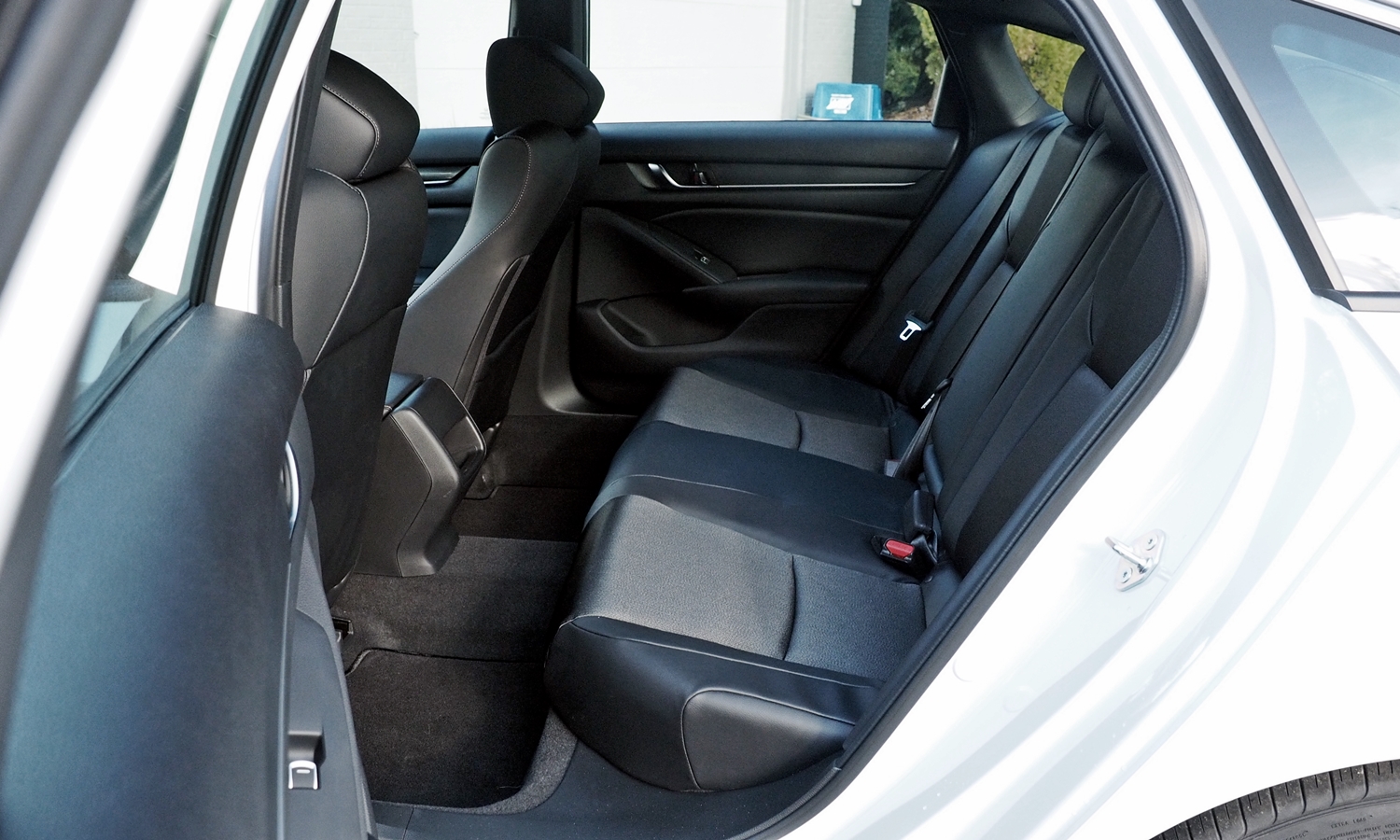
Tremendous rear legroom, but limited rear headroom.
| |
Compared to the Camry |
| Powertrain performance |
 Better
Worse
Better
Worse
|
Will you want the new Accord with the 192-horsepower turbocharged 1.5-liter engine or with the 252-horsepower turbocharged 2.0-liter engine? The tested car, with the 1.5-liter, was plenty quick for all practical purposes. Boost lag was nearly undetectable. But if you want thrilling acceleration, you'll want the 2.0T.
The manual transmission in the tested car wasn't among Honda's best (which are among the best of the best). Instead, it felt a little rough and clunky. Not a bad shifter, but not a great one, either. This was a press fleet car, so it might have suffered from abuse. Or maybe, recognizing that few buyers would opt for the manual, Honda didn't put a lot of effort and expense into refining this one. I'd have to drive a second example to be sure.
Shift feel aside, the engine also holds onto revs for a long, long time after the clutch is depressed. While likely done for emissions reasons, this "rev hang" detracts from perceived responsiveness.
Then again, the only competitor to even offer a manual transmission is Mazda. Honda deserves kudos (and customers) for offering a manual at all. And if I was getting an Accord it would be a stick-shift Sport. While a manual transmission can feel out of place in a largish sedan, one feels right at home in the new Accord thanks to its agile handling.
Don't want to fuss with a clutch? Then the 1.5T pairs with a CVT (manually shiftable in the Sport and Touring) while the 2.0T pairs with a manually shiftable ten-speed automatic, a first for a front-wheel-drive car. While Honda's CVTs are among the best-behaved, many drivers will probably prefer the feel of the conventional automatic. (I haven't driven an Accord with the new ten-speed yet, so I cannot comment on it.)
No matter how well the new 2.0T engine performs, many people will miss the great-sounding, smooth-revving 278-horsepower 3.5-liter V6 from previous Accords.
With larger, non-turbocharged engines, the Toyota Camry turns in almost identical acceleration times in the magazines' testing. But the big four in the Camry SE I drove sounded and felt a bit rough. No one will rev it for the sounds it then makes.
| Driving position & visibility |
 Better
Worse
Better
Worse
|
Nothing distinguishes the new Honda Accord and Toyota Camry more from one another than their driving positions. Back in the 1980s Honda was known for ultra-low instrument panels and huge windows. That Honda is long gone and apparently isn't coming back.
The latest Accord has an even lower seating position relative to the instrument panel than the previous ones. I raised the driver seat all of the way in front and most of the way in back just to get a decent view over the instrument panel. Otherwise I felt buried in the car. While the new Accord's lower seating position contributes to a sportier and more upscale feel, it isn't best for outward visibility. Other aspects of the car's design--a fairly compact instrument panel and relatively thin A-pillars--help compensate.
In sharp contrast, you sit so high above the instrument panel in the Camry that I wanted to lower the seat below its lowest position. Compared to those in the Accord, the Camry's windows are huge. Shorter drivers might greatly prefer the Camry for this reason.
I found the driver seat in neither car notably good or bad. In some Hondas the fixed lumbar bulge can be uncomfortably sized or positioned for more than a few people, but all Accords except the LX have four-way adjustable lumbar for the driver. The EX-L and Touring have the same for the front passenger.
| Exterior styling |
 Better
Worse
Better
Worse
|
The Honda Accord was never among the most attractive sedans. But the second-generation sedan (1982-1985) had handsomely tailored styling that owed more than a little to BMW and the third-generation sedan (1986-1989) had nifty pop-up headlights.
Subsequent generations (with the partial exception of the fifth) were so generic they were virtually invisible.
Well, they've fixed that with the tenth. While the ninth-generation Accord marked a return to cribbing off BMW, the new car's body side surfacing most resembles the latest from Audi. Not everyone will like it. I'm a fan. With the new styling the Accord appears much sleeker, much sportier, and much more upscale.
That the new car appears dramatically longer, lower, and wider than both the previous Accord and the new Toyota Camry further testifies to the skill of its designers. The largest dimensional difference: the new Accord is nine-tenths of an inch wider than the new Camry. The smallest: it's a mere tenth of an inch longer--and three-tenths of an inch less lengthy than the old Accord.
The Accord's new face, with a big black Dodge Charger-like grille that dips deeply into the bumper, has been inciting...comments. It's easily the worst aspect of the exterior. Still, I'm personally okay with it. Opt for a trim level other than the Sport and a chrome bar connects the headlights, providing some relief from the big black hole. Not everyone sees this as an improvement.
Toyota also tried to make the Camry appear sportier and more dramatic with the latest redesign. They might have tried too hard. While the new Camry will definitely catch more eyes than the old one, many will not like what they see. There's too much going on in the tortured body sides and the new faces range from angry alien to just odd.
| Materials & workmanship |
 Better
Worse
Better
Worse
|
There's nothing flashy about the new Honda Accord's interior, and this is a good thing. For about a decade Honda's designers tried to put a little (or more than a little) spaceship into their interiors. In welcome contrast the new Accord's interior adheres closely to the principles of good, clean, functional design. Even the LCD portion of the instrument cluster (the tach and everything around it) pulls off a very good impersonation of classic analog gauges. Many people won't realize that the tach is an LCD while the speedometer is not.
Toyota's interior designers were more adventurous, with a dramatic S-curve bisecting the center stack. I like this design element in itself, but as executed it seems plasticky. This is a general shortcoming of the Camry's interior. While both cars' interiors employ similar amounts of hard plastic, and the Camry's has an upholstered and stitched instrument panel face that the Accord's lacks, the Toyota's interior overall looks and feels considerably cheaper. Toyota's designers checked off a number of the right boxes, but the rest of the product development team failed to properly finesse the execution.
| Reliability & durability |
 Better
Worse
Better
Worse
|
I haven't listed reliability among the reasons to buy a new Accord because we have no data on it yet. Also, all-new Hondas can be somewhat glitchy in their first model year. Most likely, though, once any initial glitches are sorted out the new Accord will prove just as solid a bet as previous generations.
Among competitors, only the Toyota Camry tends to be more reliable, and the difference is small enough that it shouldn't concern most people.
And yet it's worth nothing that, while Honda has switched to new turbocharged engines, Toyota has stuck with naturally aspirated engines closely related to those used in the previous two generations of the car. The Honda's transmissions, a CVT with the 1.5T engine and an all-new ten-speed automatic with the 2.0T engine, are also iffier than the Toyota's more conventional and more proven six- and eight-speed transmissions. Honda has badly bothced new automatic transmission designs in the past. Concerned? Then get an Accord Sport with the six-speed manual.
Thanks to their records of reliability, both sedans tend to hold their value much better than competitors. People pay crazy money for old Hondas.
The tenth-generation Honda Accord sedan looks and drives like a premium car, without the price of one. What Honda's engineers have done with the chassis tuning (especially in the Sport and Touring) borders on magical. Fuel economy tops the class in city and suburban driving. Inside, you'll find exceptionally well-designed controls, a very welcome reversal of recent Honda practice and a return to auto maker's "we make it simple" glory days. Plus far more rear legroom than in any classic Honda, and even considerably more than in the current Camry.
The new Camry handles more tightly and precisely than any previous Camry. Its steering communicates better than the Honda's. Aside from an offputting face (an issue shared with the Accord) it's also more stylish than past Camrys, and it's absolutely more exciting to both look at and drive. But despite the obvious effort to spiff the car up you'll still see and feel a transportation appliance lurking within.
The new Accord, in sharp contrast, is no appliance. For the first time in decades Honda has created an Accord that seems special.
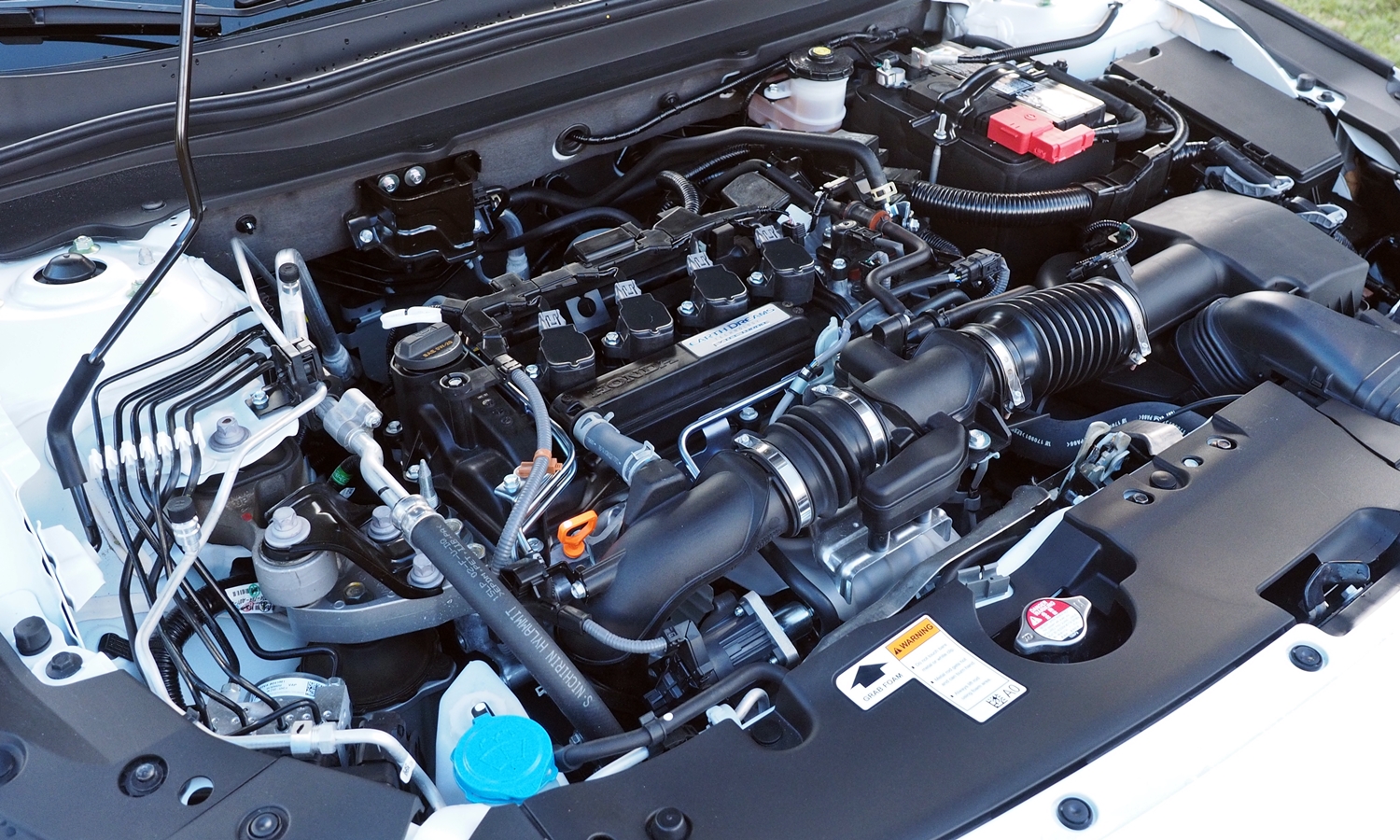
192-horsepower turbocharged 1.5-liter engine delivers quick acceleration and excellent fuel economy.
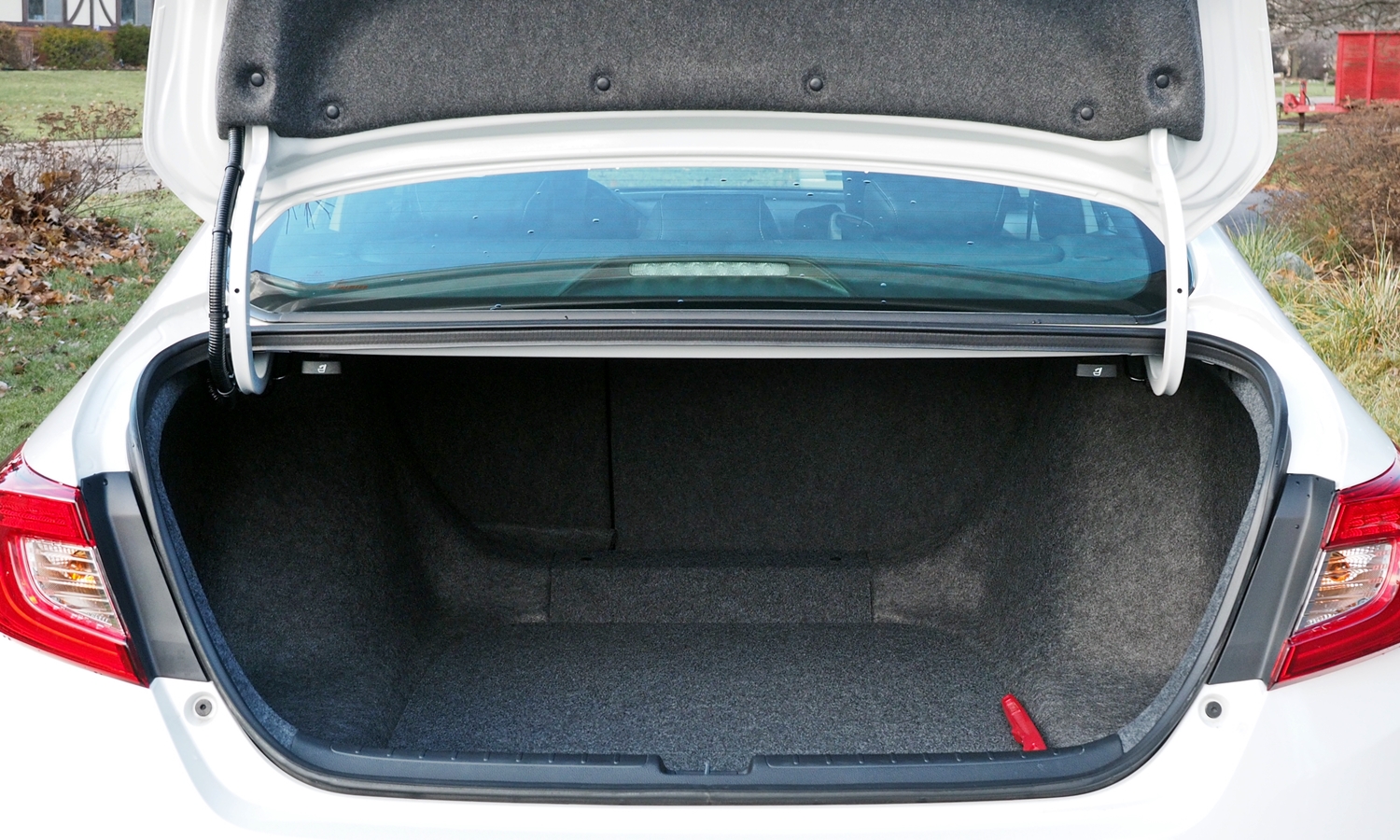
Roomiest trunk, but others are close.
See more 2018 Honda Accord photos
Honda and Mazda each provided insured cars for a week with a tank of gas. Lawrence Dixon (248-525-0004) of Szott Toyota in Waterford, MI, provided a Camry SE for a comparison drive.











